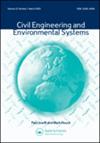Vibration performance of timber-concrete composite floor section –verification and validation of analytical and numerical results based on experimental data
IF 1.1
3区 工程技术
Q3 ENGINEERING, CIVIL
引用次数: 2
Abstract
ABSTRACT Vibration performance of a one-way simply supported timber-concrete composite (TCC) floor section has been studied using analytical as well as numerical methods. Focal points have been verification and validation of results from analytical and numerical calculations of vibration response based on experimental data. For the analytical calculations, floor bending stiffness and vibrational response are determined from methods proposed in the current and revised versions of Eurocode 5. The numerical calculations based on the finite element (FE) method are done using 3D solid elements with orthotropic material parameters. When comparing the results of the FE analysis, better agreement with the experimental data is reached for the fundamental frequency when 3D solid elements are used rather than 3D beam elements. Furthermore, better agreement with the experimental data is reached for RMS acceleration by FE analysis rather than the method based on Eurocode 5. For detailed analysis, the authors suggest performing dynamic FE analysis and calculating vibration response from the TCC floor’s modal responses as eigenmodes and natural eigenfrequencies below 40 Hz. For future studies, it is recommended that the verification of vibration response may be accomplished by applying standard EN 16929.木结构-混凝土组合楼盖截面的振动性能——基于实验数据的解析和数值结果的验证与验证
摘要采用解析和数值方法研究了单向简支木-混凝土复合材料(TCC)楼板截面的振动性能。重点对基于实验数据的振动响应分析和数值计算结果进行了验证和验证。对于分析计算,楼板的弯曲刚度和振动响应是根据现行和修订版本的欧洲规范5中提出的方法确定的。采用具有正交各向异性材料参数的三维实体单元进行了基于有限元法的数值计算。对比有限元分析结果发现,采用三维实体单元比采用三维梁单元时基频与实验数据吻合得更好。与基于欧洲规范5的方法相比,采用有限元方法计算的均方根加速度与实验数据更符合。为了进行详细的分析,作者建议进行动态有限元分析,并从TCC楼板的模态响应计算振动响应,作为特征模态和固有特征频率低于40 Hz。对于未来的研究,建议通过应用EN 16929标准来验证振动响应。
本文章由计算机程序翻译,如有差异,请以英文原文为准。
求助全文
约1分钟内获得全文
求助全文
来源期刊

Civil Engineering and Environmental Systems
工程技术-工程:土木
CiteScore
3.30
自引率
16.70%
发文量
10
审稿时长
>12 weeks
期刊介绍:
Civil Engineering and Environmental Systems is devoted to the advancement of systems thinking and systems techniques throughout systems engineering, environmental engineering decision-making, and engineering management. We do this by publishing the practical applications and developments of "hard" and "soft" systems techniques and thinking.
Submissions that allow for better analysis of civil engineering and environmental systems might look at:
-Civil Engineering optimization
-Risk assessment in engineering
-Civil engineering decision analysis
-System identification in engineering
-Civil engineering numerical simulation
-Uncertainty modelling in engineering
-Qualitative modelling of complex engineering systems
 求助内容:
求助内容: 应助结果提醒方式:
应助结果提醒方式:


